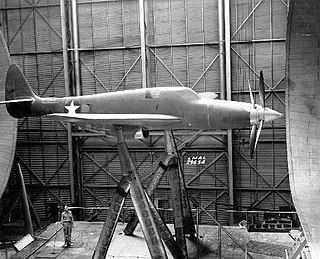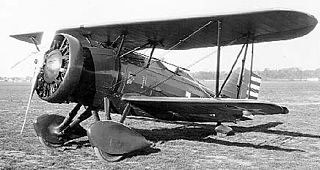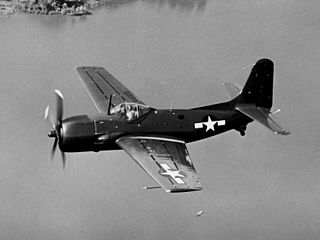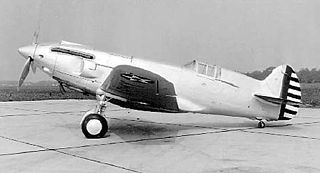
The Curtiss P-36 Hawk, also known as the Curtiss Hawk Model 75, is an American-designed and built fighter aircraft of the 1930s and 40s. A contemporary of the Hawker Hurricane and Messerschmitt Bf 109, it was one of the first of a new generation of combat aircraft—a sleek monoplane design with a retractable undercarriage making extensive use of metal in its construction.

The Curtiss XP-46 was a 1940s American prototype fighter aircraft. It was a development of the Curtiss-Wright Corporation in an effort to introduce the best features found in European fighter aircraft in 1939 into a fighter aircraft which could succeed the Curtiss P-40, then in production.

The Curtiss XP-62 was a prototype single-engine interceptor aircraft, that was built for the United States Army Air Forces, by the Curtiss-Wright Corporation. It first flew in 1943.

The Republic XP-72 was an American prototype fighter-interceptor developed by Republic Aircraft as a progression of the P-47 Thunderbolt design. The XP-72 was designed around the Pratt & Whitney R-4360 Wasp Major 28-cylinder air-cooled radial engine with a supercharger mounted behind the pilot and driven by an extension shaft from the engine. The armament consisted of six .50 caliber (12.7 mm) wing-mounted Browning AN/M2 machine guns and underwing racks for two 1,000 lb bombs; Alternative armament packages included two 37 mm M4 autocannons with four .50 caliber AN/M2s, or four M4 autocannons.

The Republic XP-69 was an American fighter aircraft proposed by Republic Aviation in 1941 in response to a requirement by the United States Army Air Corps for a high-speed fighter. Manufacturers were encouraged to consider unorthodox designs; although the design was ordered as a prototype it was canceled because of delays with the engine that was to power it.

The Curtiss P-6 Hawk is an American single-engine biplane fighter introduced into service in the late 1920s with the United States Army Air Corps and operated until the late 1930s prior to the outbreak of World War II.

The P-1 Hawk was a 1920s open-cockpit biplane fighter aircraft of the United States Army Air Corps. An earlier variant of the same aircraft had been designated PW-8 prior to 1925.

The Vought SBU-1 Corsair was a two-seat, all-metal biplane dive bomber built by Vought Aircraft Company of Dallas, Texas for the US Navy. Its design was based upon the F3U-1 two-seat fighter that was abandoned when the Navy decided not to obtain any more two-seat fighters.

The Curtiss SC Seahawk was a scout seaplane designed by the Curtiss Aeroplane and Motor Company for the United States Navy during World War II. The existing Curtiss SO3C Seamew and Vought OS2U Kingfisher were gradually replaced by the Seahawk in the late stages of the war and into peacetime.

The Curtiss F6C Hawk is a late 1920s American naval biplane fighter aircraft. It was part of the long line of Curtiss Hawk airplanes built by the Curtiss Aeroplane and Motor Company for the American military.

The Curtiss F7C Seahawk was a carrier-capable biplane fighter aircraft of the United States Navy Marine Corps in the late 1920s and early 1930s.

The XP-13 Viper was a prototype biplane fighter aircraft designed by the American company Thomas-Morse Aircraft Corporation. The airplane was delivered to the United States Army in 1929, but they did not adopt it.

The Boeing P-29 and XF7B-1 were an attempt to produce a more advanced version of the highly successful P-26. Although slight gains were made in performance, the U.S. Army Air Corps and U.S. Navy did not order the aircraft.

The Grumman XSBF, also known by the company designation G-14, was an American biplane scout bomber developed by Grumman Aircraft for the United States Navy during the 1930s. Derived from Grumman's successful "Fifi" fighter, the aircraft was developed at a time when the biplane was giving way to the monoplane. In competition against other aircraft it proved to possess inferior performance in its intended role, and did not enter production. The sole prototype went on to serve as a liaison aircraft, as well as being used in experiments by NACA, before being destroyed in a crash in 1939.

The Curtiss YP-20 was an American biplane fighter project developed by Curtiss for the United States Army Air Service.

The Curtiss XP-22 Hawk was a 1930s American experimental biplane fighter built by Curtiss for evaluation by the United States Army Air Service.

The Curtiss XBT2C was a prototype two-seat, single-engined dive/torpedo bomber developed during World War II for the United States Navy. Derived from the Curtiss SB2C Helldiver dive bomber, it was an unsuccessful competitor to meet a 1945 Navy specification for an aircraft to combine the roles that previously required separate types. Unlike the other competitors, the XBT2C was designed to accommodate a radar operator.

The Curtiss P-37 was an American fighter aircraft made by Curtiss-Wright in 1937 for the US Army Air Corps. A development of the Curtiss P-36 Hawk to use an inline engine instead of the radial engine of the P-36 the fuselage was lengthened and the cockpit moved back. A small number of YP-37 aircraft was built for Air Corps evaluation. The expected top speed was not achieved and the project terminated in favor of the Curtiss P-40.

The Granville Gee Bee R-6 International Super Sportster, named "Q.E.D.", and later named "Conquistador del Cielo", was the last in a series of racing and touring monoplane aircraft from the Granville Brothers. The R-6H was dogged with bad luck throughout its career and never finished any race it entered.

The Curtiss CA-1 was an American five-seat biplane amphibian designed by Frank Courtney and built by Curtiss-Wright at St Louis, Missouri.





















